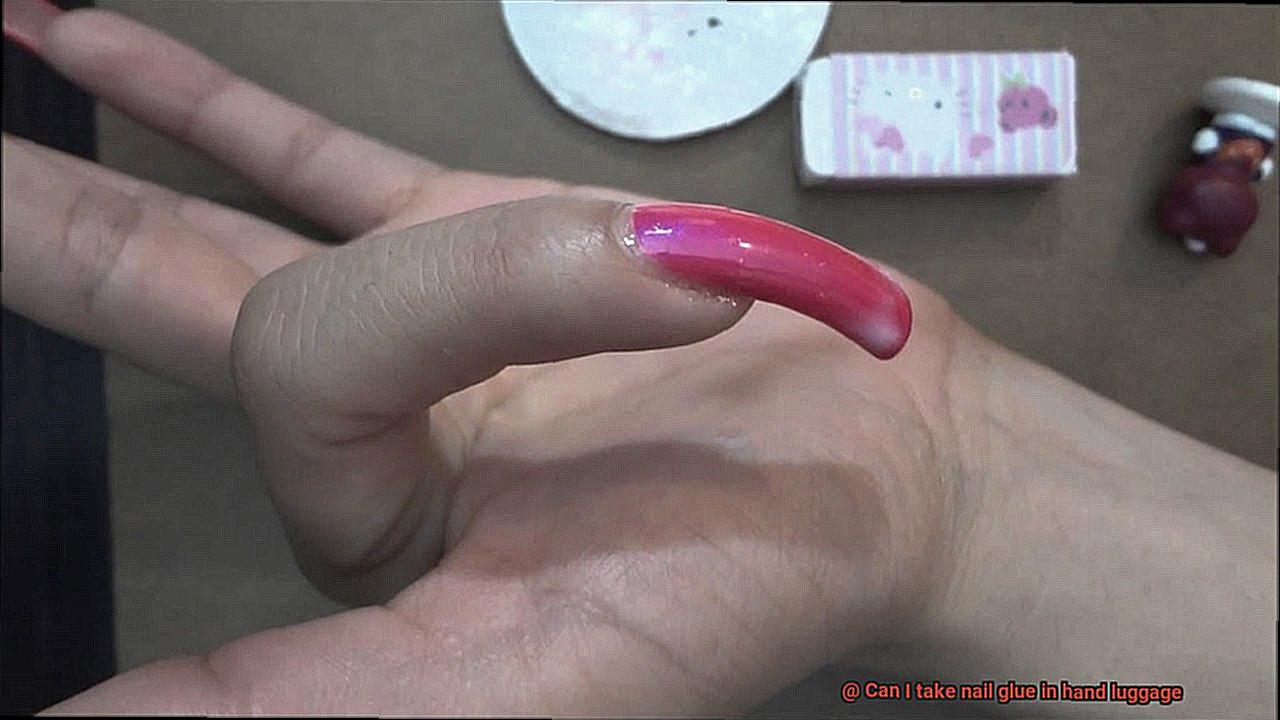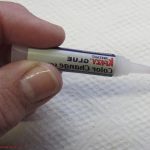Imagine this: you’re eagerly getting ready for your long-awaited getaway, meticulously arranging your belongings to meet airport rules. Amidst the excitement, a tiny but crucial question pops into your head: Can I take nail glue in hand luggage? Ah, the joys of travel conundrums.
Whether you’re a die-hard nail fanatic committed to upholding your flawless manicure or a seasoned pro in the beauty biz, this puzzle can leave you scratching your head. After all, nail glue holds incredible power over our stunning nail extensions, intricate designs, and even those last-minute fixes when things go awry.
Fear not, fellow beauty enthusiasts. We’re about to dig deep into the realm of travel and unveil the truth about carrying nail glue in your carry-on bag. Join me on this journey as we explore what’s allowed and what’s off-limits, unraveling the secrets behind keeping those perfect nails intact while soaring through the skies.
With a mix of casual curiosity and expert advice, let’s embark on this enlightening quest and put all your nail glue-related worries to rest. Just remember, we’ve got this sticky situation handled like pros.
What is Nail Glue?
Contents
- 1 What is Nail Glue?
- 2 TSA Regulations for Carrying Liquids, Gels, and Adhesives in Hand Luggage
- 3 Can I Take Nail Glue in Hand Luggage?
- 4 Size Restrictions on Containers of Liquids, Gels, and Adhesives
- 5 Placing Liquids, Gels, and Adhesives in a Clear Quart-Sized Plastic Bag
- 6 Manufacturer’s Instructions on Nail Glue Packaging
- 7 Potential Security Risks Due to Adhesive Properties of Nail Glue
- 8 Checking Airline or TSA Website for Up-to-Date Information on Transporting Nail Glue in Hand Luggage
- 9 Conclusion
Here, we will explore the world of nail glue, uncovering its purpose, usage, and everything you need to know about this essential beauty product.
What is Nail Glue?
Nail glue is a specialized adhesive that is specifically designed to bond artificial nails, nail tips, and embellishments to your natural nails. It typically comes in small bottles or tubes and is available in various formulations, with cyanoacrylate-based glues being the most common. These glues are renowned for their fast-drying and strong bonding properties.
How Does Nail Glue Work?
Nail glue works by initiating a chemical reaction when it comes into contact with moisture, such as the natural oils on your nails. This reaction causes the glue to harden quickly, creating a secure and long-lasting bond between the artificial nails and your natural nails. The result is professional-looking nail enhancements that withstand everyday activities.
Versatility Beyond Artificial Nails:
Nail glue offers more than just attaching artificial nails. It can also be used for repairing broken or split nails, fixing nail enhancements, or even adhering nail art decorations like rhinestones or decals. Its versatility makes it an indispensable tool in any beauty arsenal.
Choosing the Right Nail Glue:
When selecting a nail glue, it is crucial to prioritize quality and safety. Opt for reputable brands that specifically formulate their glues for nail applications. These brands undergo rigorous testing to ensure their products are safe and effective.
Safety Precautions:
While nail glue is a fantastic tool for achieving stunning nails, it must be used with care. Avoid applying excessive amounts of glue and keep it away from your skin and eyes. If you experience any adverse reactions, remove the glue immediately and seek medical attention if necessary.
TSA Regulations for Carrying Liquids, Gels, and Adhesives in Hand Luggage
I’ve got all the juicy details on TSA regulations for carrying liquids, gels, and adhesives in your hand luggage.
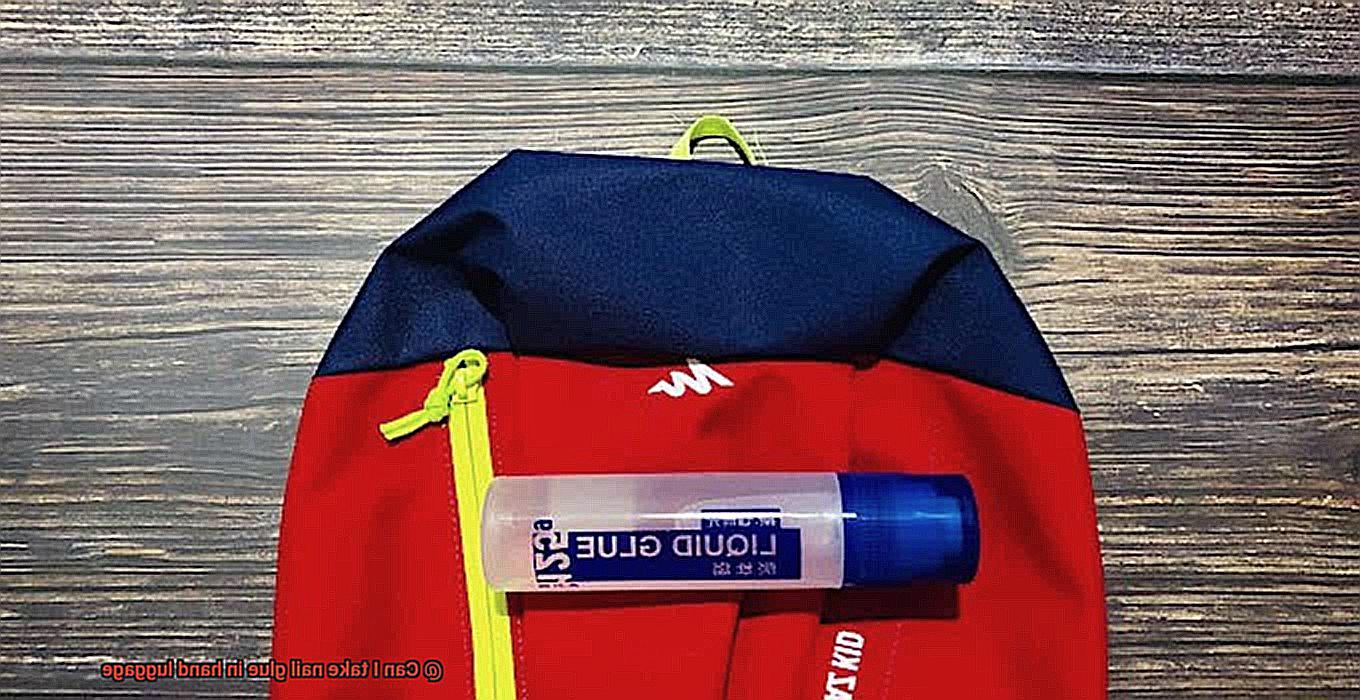
Let’s start with the basics. The Transportation Security Administration (TSA) has some specific rules in place to ensure the safety of everyone on board. These rules apply to liquids, gels, and adhesives, including our beloved nail glue. So, listen up, nail connoisseurs.
According to the TSA guidelines, you can bring nail glue in your carry-on bag as long as it’s in a container that is 3.4 ounces or less. That’s about 100 milliliters, for those who like precision. And here’s a pro tip: if you’re traveling with other liquid goodies, make sure to pack them together in a clear plastic bag. It’s like creating a little VIP club for your nail glue and other liquids.
But what if your nail glue container is bigger than the magical 3.4-ounce limit? Well, my friend, you’ll have to check it in with your luggage. I know, it’s a bummer when we want our nails on point during the flight. But safety comes first.
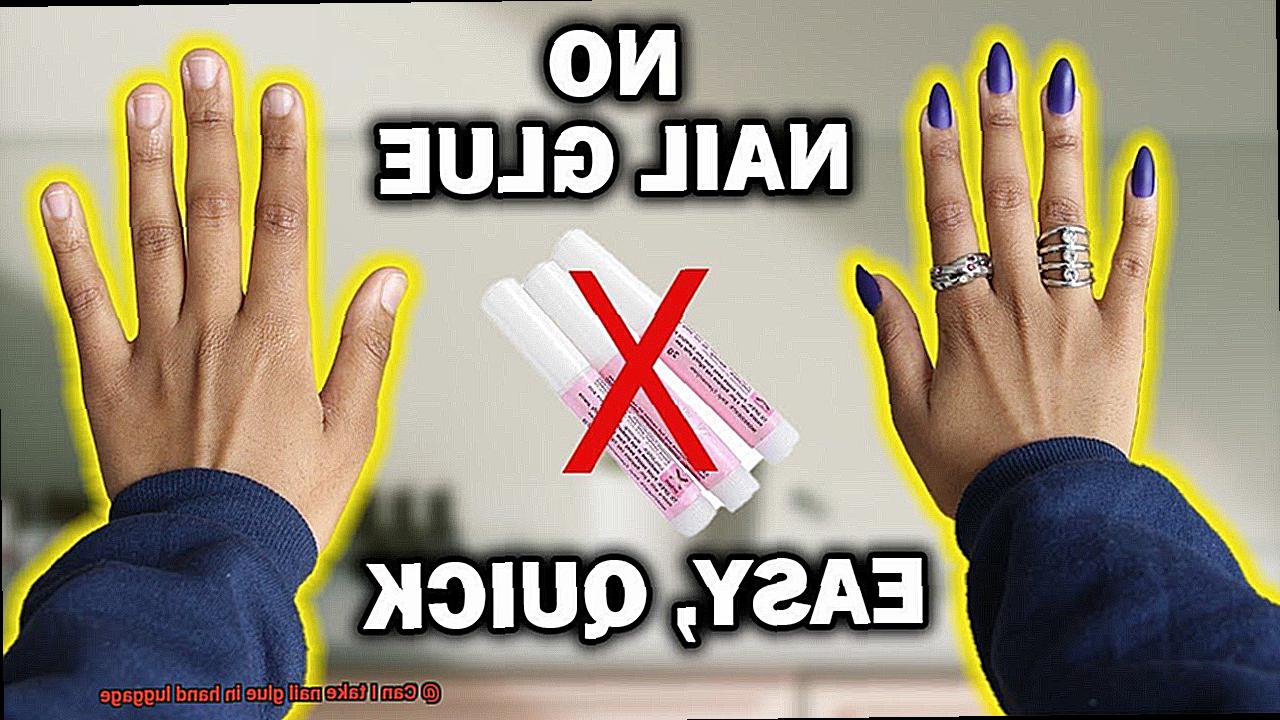
To make things smoother for everyone involved, the TSA recommends labeling your nail glue container (and any other liquids too). This simple act can prevent any confusion during the security check and speed things up. We all love a speedy security check, don’t we?
Now, here’s a little reminder: these regulations might vary depending on the country you’re flying from or to. So, I’d suggest double-checking with your airline or airport for any additional rules they may have. Better safe than sorry.
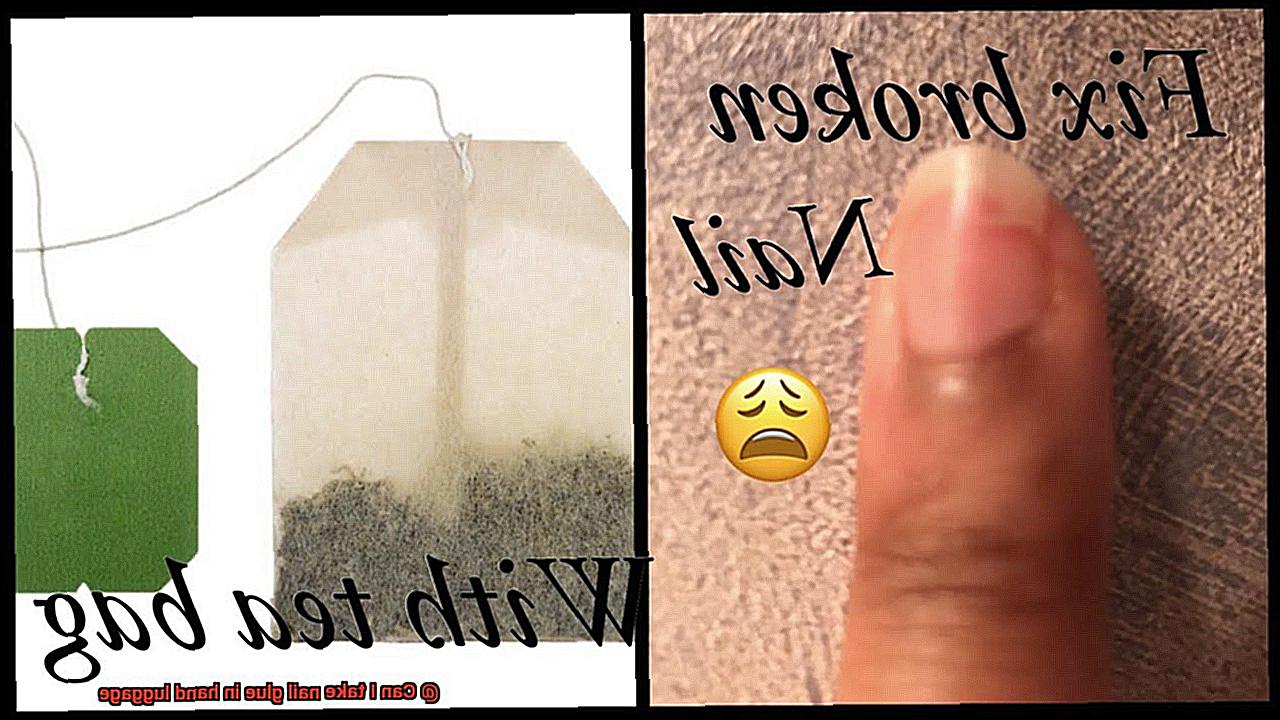
Can I Take Nail Glue in Hand Luggage?
I have done the research for you. Let’s delve into the world of TSA regulations and find out if your nail glue can fly high with you on your next adventure.
Nail glue is an essential component of any nail care or nail art kit. It’s the magical adhesive that keeps your artificial nails, extensions, or tips securely in place. But when it comes to air travel, we must abide by rules and regulations to ensure safety during the flight.
Most airlines follow the guidelines set by the Transportation Security Administration (TSA). These guidelines restrict the amount of liquids, gels, and adhesives that can be carried in hand luggage. The good news is that nail glue typically comes in small bottles or tubes, which fall within the acceptable limits set by the TSA.
According to TSA guidelines, liquid or gel-like substances carried in hand luggage must be in containers that are 3.4 ounces (100 milliliters) or less per item. These containers should also be placed in a clear plastic bag along with other liquids and gels. So if your nail glue bottle or tube contains less than 3.4 ounces of product, you’re good to go.
However, there’s a slight catch. TSA regulations can vary between countries or airlines. So before you embark on your journey, it’s always wise to check with your specific airline or consult their website for any additional restrictions or requirements.
To ensure a smooth airport experience, pack your nail glue and other liquids or gels separately in a clear plastic bag. Keep it easily accessible in your hand luggage so you can whip it out during the security screening process without any hassle.
Now, if you’re concerned about crossing the line with your nail glue container size or exceeding the allowed limit, it’s best to pack it in your checked baggage instead. This way, you can avoid any potential confiscation or delays during the security screening process.
So, there you have it, my fellow nail enthusiasts. As long as your nail glue container is within the allowed limits, you can jet off with confidence, knowing your fabulous nails are ready to take flight. Just remember to double-check your airline’s regulations to be on the safe side.
Size Restrictions on Containers of Liquids, Gels, and Adhesives
When it comes to traveling with liquids, gels, and adhesives in your hand luggage, it’s essential to be aware of the size restrictions in place. These restrictions are not just arbitrary rules; they exist for security reasons, as larger containers could potentially hold more than the allowed limit of liquid or gel substances.
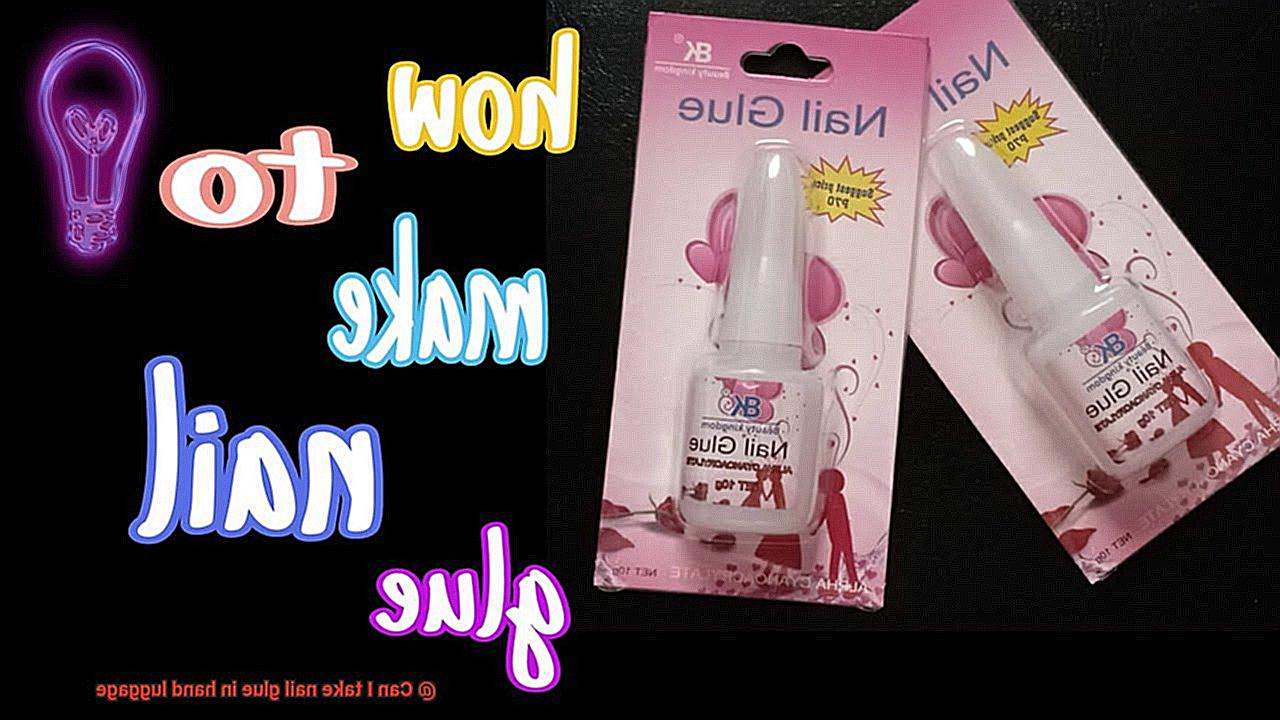
In the United States, the Transportation Security Administration (TSA) has specific guidelines that must be followed. According to these regulations, all liquids and gels must be carried in containers that are 3.4 ounces (100 milliliters) or less. This includes nail glue, as it falls under the category of adhesives.
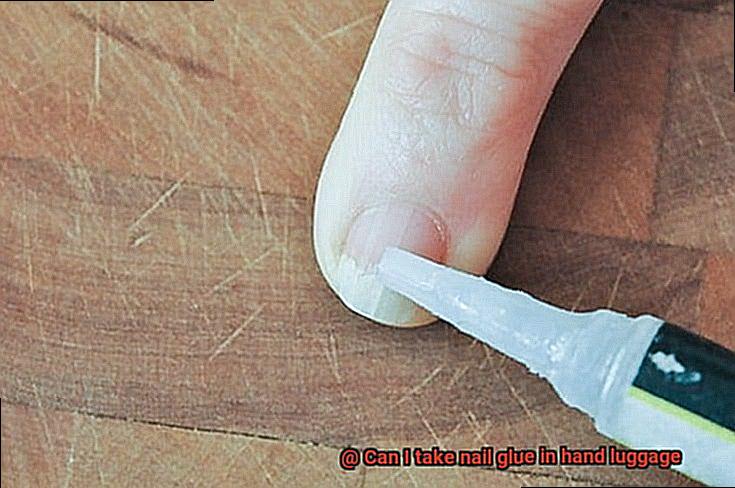
To ensure compliance with these regulations, it’s crucial to check the size of your nail glue container. Make sure it is 3.4 ounces or less, regardless of whether it is fully or partially filled. Any container exceeding this limit will not be allowed in your hand luggage.
To make the security process smoother, TSA recommends placing all small containers of liquids and gels, including nail glue, in a clear quart-sized bag. This bag should be easily accessible for inspection at the security checkpoint. It’s worth noting that you can carry multiple small containers of liquids and gels as long as they fit within a single quart-sized bag. So go ahead and pack different shades of nail polish or other liquid beauty products, as long as they meet the size requirements.
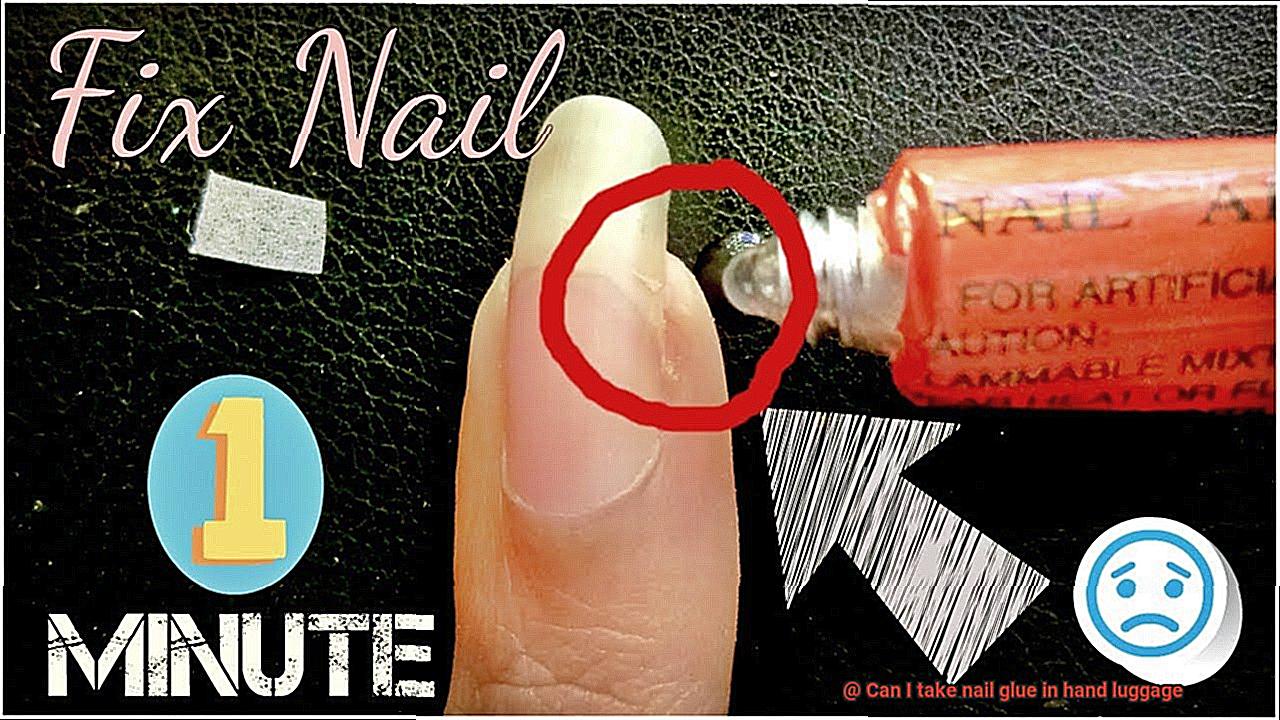
While these guidelines cover most situations, it’s advisable to check with the specific airline you’re traveling with for any additional restrictions or requirements they may have regarding nail glue or other adhesives in hand luggage.
Placing Liquids, Gels, and Adhesives in a Clear Quart-Sized Plastic Bag
I’m here to guide you through the process of packaging and transporting your beloved adhesive in your hand luggage. Trust me, your nails will thank you.
First things first, let’s talk about the regulations set by the Transportation Security Administration (TSA). They have some guidelines in place to ensure the safety of all passengers, and that includes how we handle liquids, gels, and adhesives. Lucky for us, nail glue falls under the adhesive category, which means we can bring it with us on our travels – as long as we follow the rules.
The most important rule is the quart-sized plastic bag rule. This means that all liquids, gels, and adhesives must be placed in a clear quart-sized plastic bag for easy inspection. This bag should be sealed and easily accessible for screening. So ladies (and gents), make sure to keep that baggie at the top of your hand luggage or in an outer pocket for quick access during security checks.
Now let’s talk about the specific packaging requirements for nail glue. To prevent any leakage or spills during your journey, it’s best to seal your nail glue properly. You can either use a travel-sized container or transfer a small amount of glue into a leak-proof travel bottle before placing it in the plastic bag. This way, you’ll avoid any unwanted messes and keep your hand luggage looking pristine.
Remember, each container in the plastic bag should not exceed 3.4 ounces (100 milliliters) in capacity. If your nail glue exceeds this limit, it’s time to bid it farewell and pack it in your checked baggage instead. We don’t want any tears shed over confiscated adhesive at security.
It’s important to note that regulations may vary from country to country or airline to airline. So before you embark on your nail adventure, make sure to check with the relevant authorities or your airline to ensure you’re following their specific guidelines. Nobody wants their nail glue dreams shattered at the security checkpoint.
One last thing to keep in mind is that nail glue can be flammable, so it’s crucial to handle it with care and follow any additional safety instructions provided by the manufacturer. Safety first, my fellow nail enthusiasts.
Manufacturer’s Instructions on Nail Glue Packaging
Nail glue, the ultimate companion for flawless artificial nails or quick fixes to our natural ones. But did you know that the instructions on the packaging are more than just fine print? They are your guide to a safe and successful nail glue experience. So, let’s delve into the research-backed tips that will make your nails shine.
First off, proper application is key. The instructions on the packaging advise applying a thin layer of glue onto the nail or artificial nail, making sure to avoid any contact with the skin. This not only ensures a strong hold but also prevents any unwanted irritation or allergic reactions. Say no to red, itchy fingers.
But what about storage? Manufacturers recommend keeping your nail glue in a cool, dry place away from direct sunlight. Think of it as preserving your favorite ice cream – keep it cool, but please don’t mistake it for a topping.
Now, let’s tackle the sticky situation of removal. Some packaging even includes instructions for that too. Whether it’s soaking your nails in warm soapy water or using a specific nail glue remover, following these instructions will save you from any nail glue nightmares.
But safety first. Nail glue packaging often includes warnings about potential hazards and precautions to take while using the product. Pay attention to these warnings to avoid any mishaps. Remember, using nail glue on damaged or infected nails can make matters worse. Take care of your nails before gluing them up.

Last but not least, allergies are real. Some individuals may have sensitivities to certain ingredients in nail glue. That’s why it’s recommended to perform a patch test before slathering on the glue all over your nails. Better safe than sorry.
Potential Security Risks Due to Adhesive Properties of Nail Glue
Imagine preparing for your dream vacation, diligently packing your hand luggage. But have you considered the potential security risks of bringing nail glue on board? In this article, we will explore the adhesive properties of nail glue and how it could pose security risks during travel. So fasten your seatbelts and get ready to delve into this sticky situation.
The Power of Nail Glue:
Nail glue is a formidable adhesive commonly used for artificial nails or repairs. Its main ingredient, cyanoacrylate, ensures a quick and secure bond. However, this same strength makes it potentially dangerous when taken in hand luggage.
Sealing Doors and Tampering with Security Systems:
- Nail glue could be used to seal doors or windows shut, trapping individuals in emergency situations without an escape route.
- Applying nail glue to keyholes or electronic sensors could disable or bypass security systems, granting unauthorized access to restricted areas.
Sabotage and Smuggling:
- The strong adhesive properties of nail glue make it difficult to separate glued items, creating opportunities for sabotage that can lead to disruptions and delays.
- Due to its small size and concealable nature, nail glue can easily go unnoticed during security screenings, making it a potential smuggling threat.
Safety Measures to Consider:
To mitigate these risks, airports and airlines have specific regulations for carrying adhesives like nail glue:
- Familiarize yourself with guidelines to ensure compliance and a hassle-free journey.
- Nail glue is typically allowed in limited quantities and should be stored in clear, resealable plastic bags alongside other liquid items.
Stay Informed:
Check with your specific airline or airport to understand their rules and requirements regarding carrying nail glue in hand luggage. Staying informed will help you avoid confiscation or complications during security screenings.
Checking Airline or TSA Website for Up-to-Date Information on Transporting Nail Glue in Hand Luggage
When it comes to traveling with nail glue in your hand luggage, it’s always better to be safe than sorry. That’s why checking the airline or Transportation Security Administration (TSA) website for up-to-date information on transporting nail glue is crucial. Here’s what you need to know:
- Prohibited Items: Airlines and the TSA have a list of items that are not allowed in hand luggage or checked luggage. Nail glue, with its adhesive properties, may be included on this list. Before you pack that favorite bottle of nail glue, make sure to check if it’s prohibited.
- Restrictions and Limitations: Even if nail glue is not prohibited, there might still be restrictions or limitations on its transportation. This could include size limitations or specific packaging requirements. Visiting the airline or TSA website will give you all the necessary details.
- Liquid Restrictions: Even if nail glue is allowed in hand luggage, it must comply with liquid restrictions imposed by airlines and the TSA. Typically, liquids must be carried in containers of 3.4 ounces (100 milliliters) or less and placed in a clear, quart-sized plastic bag. Double-check the guidelines to ensure compliance.
- Differences in Regulations: Airlines have their own rules and regulations, but the TSA provides security guidelines for all airports within the United States. Their regulations may differ slightly from those of individual airlines. So, visit both websites for a complete understanding of the rules.
- Print or Save a Copy: Have a physical reference of the regulations and guidelines provided by both the airline and TSA. Print out or save a copy on your phone for easy reference during security checks.
Conclusion
In conclusion, the answer to the burning question “Can I take nail glue in hand luggage?” is a resounding yes. But before you start celebrating, there are a few things you need to keep in mind.
According to the Transportation Security Administration (TSA), you can bring nail glue on board as long as it is housed in a container that holds 3.4 ounces or less. This applies to both liquid and gel-like versions of this essential adhesive. However, please remember that rules and regulations may vary depending on your destination and airline, so it’s always best to do some research beforehand.
To make your airport experience as smooth as possible, we highly recommend packing your nail glue separately from other liquids or gels. Pop them into a clear plastic bag for easy inspection during security checks. Oh, and don’t forget to label your nail glue container for added convenience and efficiency.
Safety first. Nail glue has the potential to be flammable, so handle it with care and keep it away from any heat sources. Always follow the manufacturer’s instructions when applying, storing, or removing this potent adhesive. We want your nail game to be strong but safe.
By staying up-to-date with the latest guidelines provided by airlines and the TSA, you can confidently jet off with your favorite nail glue in tow while ensuring compliance with all necessary security measures. So pack that perfect adhesive companion for flawless nails on your next adventure.

